Some of the links in this post may be affiliate links.
The topic of how to water orchids has caused much confusion for many people. Throughout the years, I’ve helped many clients be successful with orchid care. Keep reading to let me show you three methods that I use, and that you can be successful with, when it comes to watering your Phalaenopsis or Moth Orchid.
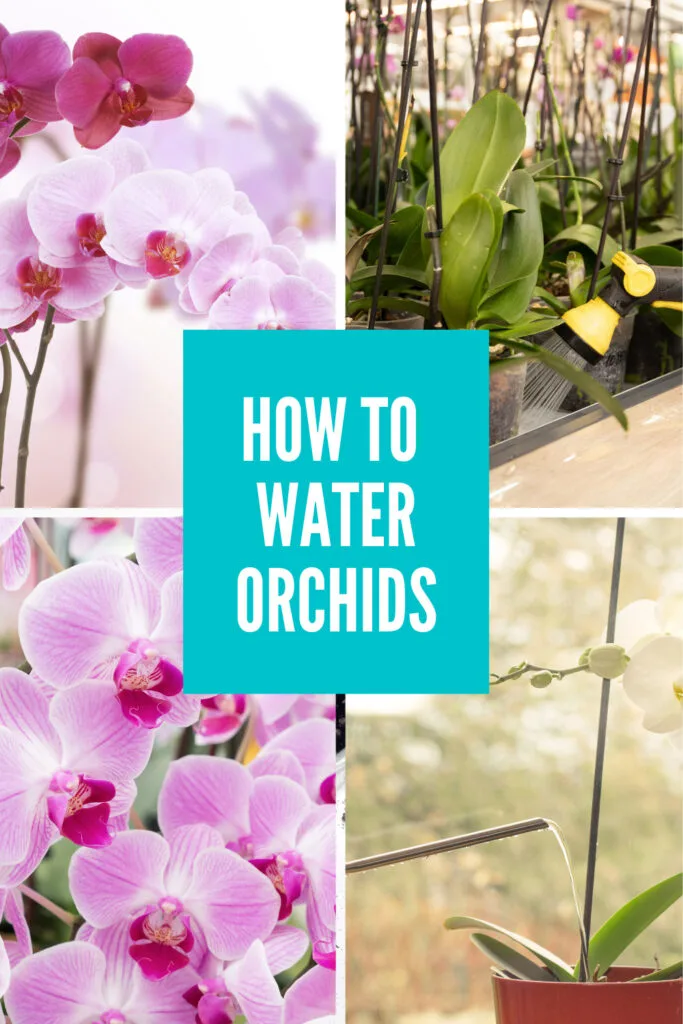
Table of Contents
What is the best way to water an orchid?
In this post, I will go through in detail 3 ways to water your orchid and some important information that you need to know about each one:
- Stream water through the pot until the potting medium is thoroughly soaked.
- Give your plant a good soak in a cachepot or bucket for a period of time (this is best for very dehydrated plants).
- Place your plants outdoors during warm weather, or during periods of rain.
Notice I did not include ice cubes as a method to water your orchids. I’ll explain why later.
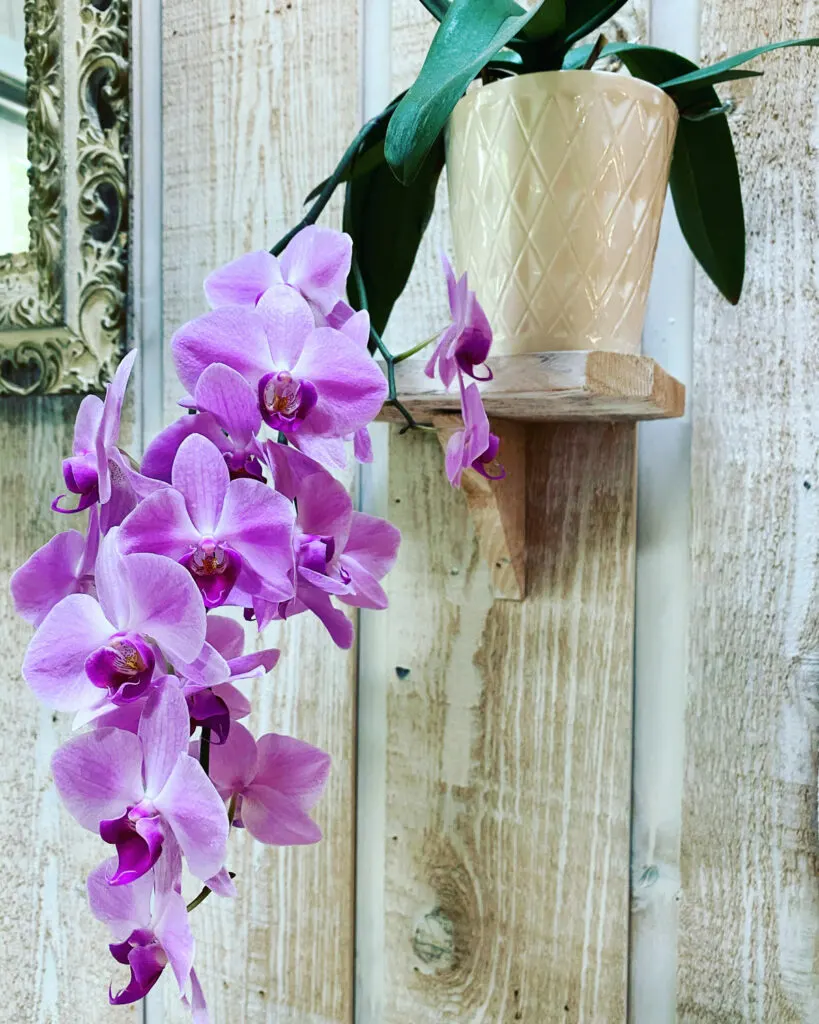
Whatever method you use, water quality is an important consideration, and if you have treated water from a water softening unit, do not use this to water your orchids.
Most of these units exchange calcium and magnesium with sodium, and sodium is toxic to plants.
The American Orchid Society also advises against using distilled water to water your orchids.
If you are using RO water or distilled water, you’ll need to add fertilizer to replace necessary nutrients. Many orchid enthusiasts have great success using the MSU Orchid Fertilizer (link to Amazon) that is specially formulated for these cases.
I personally have been using tap water for years without any issues and I live in a hard water region (though rain water would be superior if you can collect it) and I supplement with Dyna-Gro Grow fertilizer with almost every watering (1/4-/12 teaspoon per gallon).
Now let’s talk about the actual watering methods:
1. Stream Water Through in Your Sink
This is the simplest method that you can use for routine watering of your plant. Take your plant to the sink and stream lukewarm water through the pot so that you thoroughly soak the potting medium (whether you’re using orchid bark or sphagnum moss).
Be sure to moisten everything well!
Water temperature is important, so avoid using water that is too cold because this can shock your plant.
Remember, these are tropical plants and are used to warm conditions, so make sure you use tepid water and not cold water.
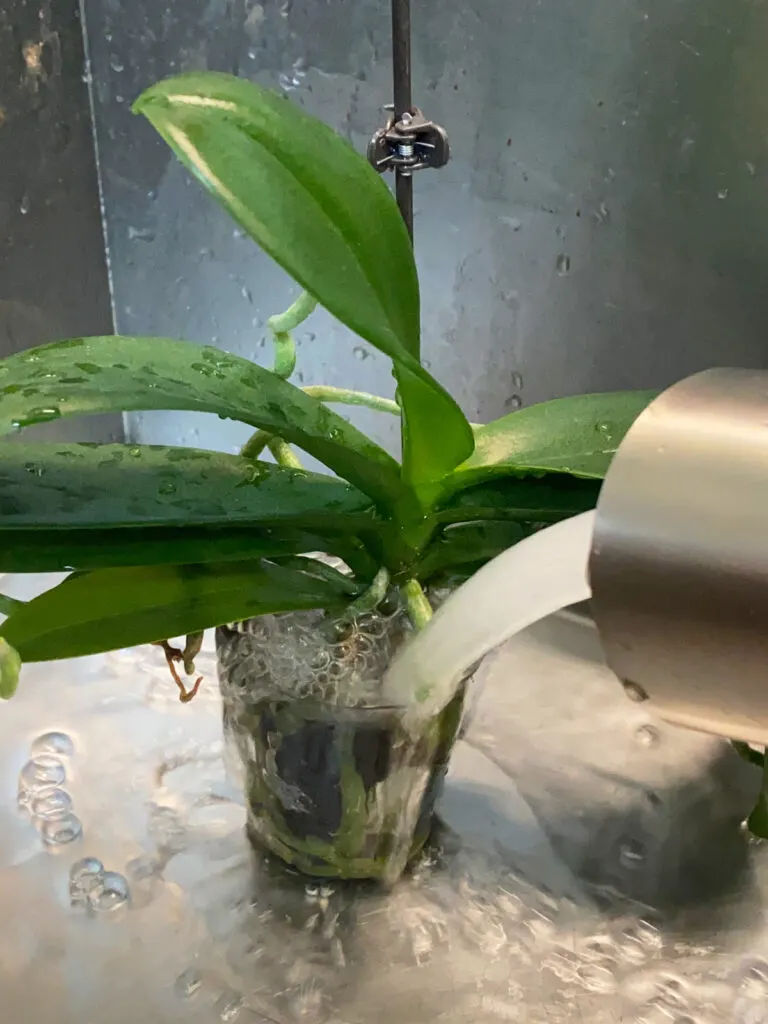
Allow all water to drain away through the drainage holes, and you’re done.
This method is great if your plant is in good condition and not terribly dehydrated. If you’ve neglected your plant and your orchid bark or sphagnum moss has gone terribly dry, I recommend using method #2 in the next section.
(If you leave your plant too dry for too long, it will first start to droop and then you will get wrinkled orchid leaves.)
I also like to wet the entire plant in order to rinse dust off the leaves and moisten any aerial roots that otherwise would not get any attention. This will also help deter and help to wash away any pests.
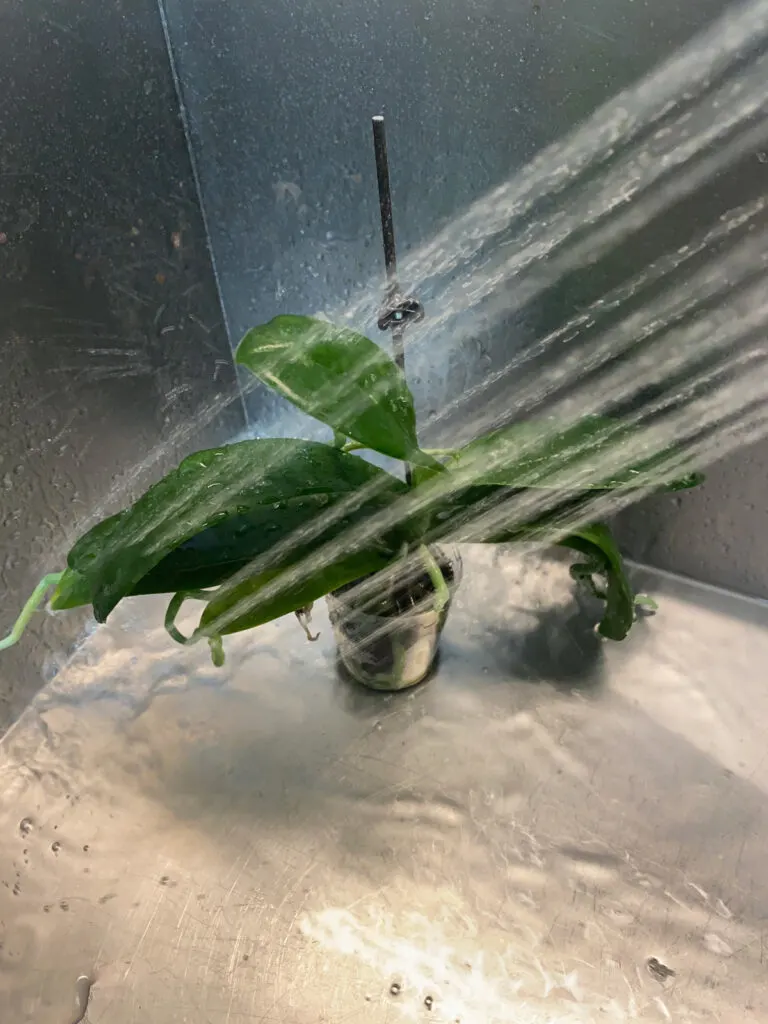
Once I’m done, I turn the plant upside down and gently shake it in order to dislodge any water that may have collected in the crown of the plant (where the leaves join together in the center of your plant).
If you have stagnant air with poor air circulation combined with water lodged in the crown of the plant, this could encourage crown rot.
If it’s impractical to turn your plant upside down, I sometimes just take a deep breath and blow out any water that has accumulated in the middle of the plant! Whatever works for you.
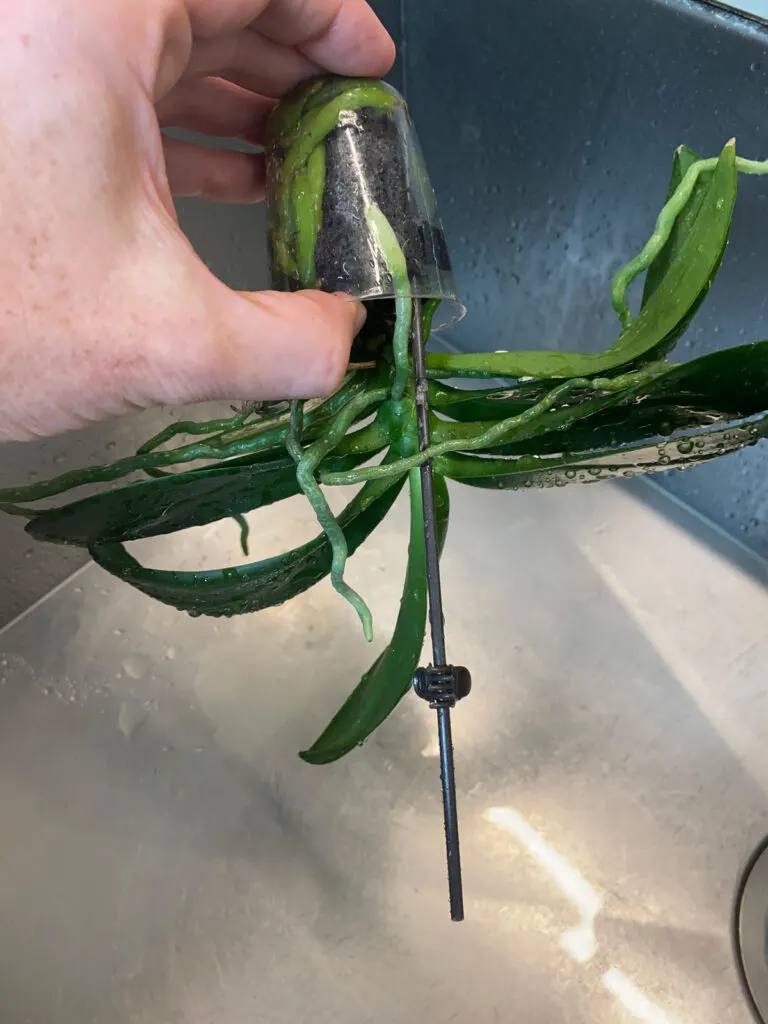
If you want to learn all about how to get your orchid to rebloom reliably and have healthy, thriving moth orchid plants, don’t miss my signature, online orchid care course, Become an Orchid Master. It also includes bonuses with support from me, personally, to guide you in your orchid journey!
2. Soak Your Orchid for More Intensive Watering
You can use this method for routine watering as well, but it is especially beneficial if your potting medium has gone really dry and you need to be able to increase the water retention to previous levels.
When bark or even sphagnum moss (whatever your orchid happens to be growing in) goes completely dry, it is sometimes difficult to “re-wet” and this method will help accomplish that.
Depending on how dry your plant is, simply slip your plant into a decorative pot or bowl of water, and let it soak for at least 15-30 minutes.
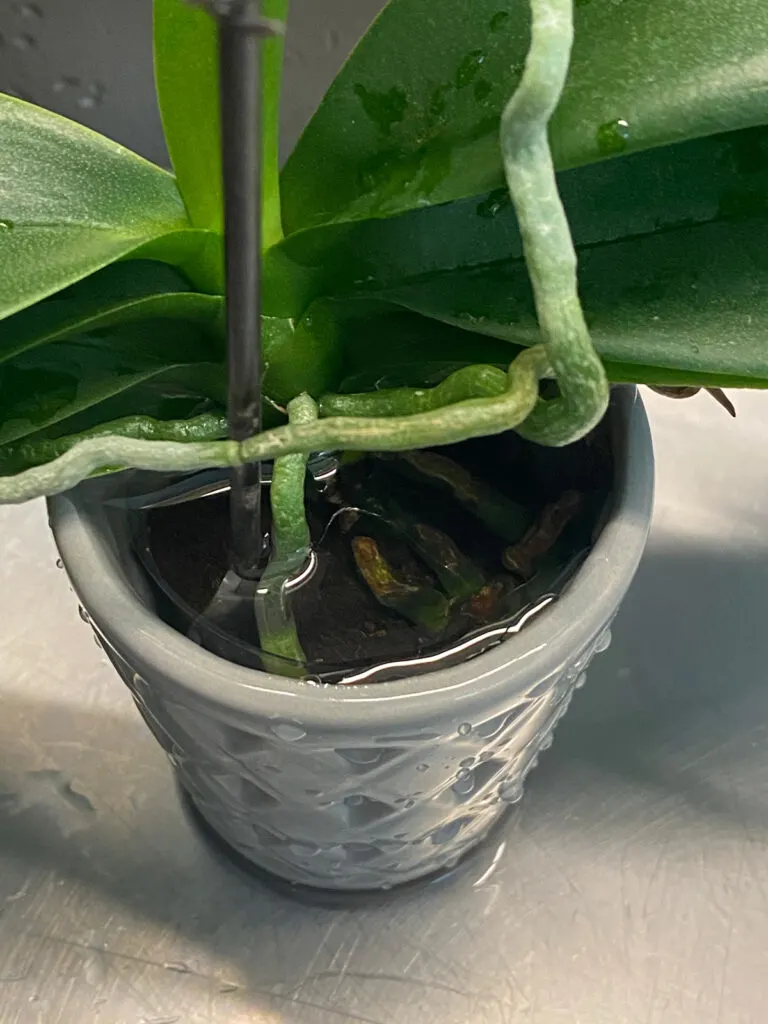
This will not rot out your plant. I’ve seen some sources saying that soaking your plant longer than 5 minutes will cause your plant to rot and it’s simply not true! You’re not leaving your orchid in water for days.
In fact, if you have a severely dehydrated plant with shriveled roots, you can use this method to soak your plant even overnight and do this at least weekly until it starts to revive.
Once your soak is done, take your plant out of the exterior pot, let the water drain out, take the exterior pot and empty the water in the bottom of the pot, slip your plant back in and you’re done.
I’ve used this method many times and have never had root rot before, as long as you have a dry period in between watering.
3. Let Mother Nature Water Your Orchids
I often take my orchids outdoors for the summer and place them in the shade for a few months. There are many benefits to placing your orchids outdoors:
- Rainwater is a superior form of water for your orchids or any houseplants. And besides this…
- The air circulation is very beneficial for plant growth.
- The natural temperature drop in the evening often triggers more blooming. Don’t allow your plants to be outside if there are extended periods below 55F (13C). They do not like cold temperatures.
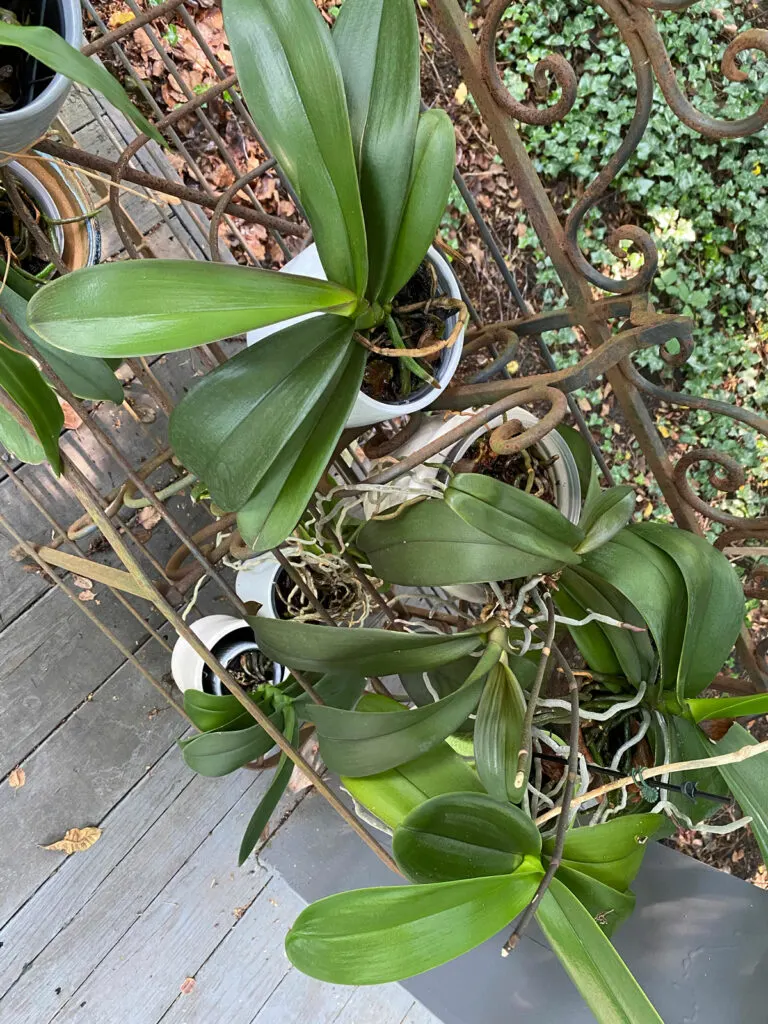
Most of my orchids are growing in clear plastic pots with drainage holes that are slipped into ceramic, decorative containers with no drainage hole.
After a good rain, if your decorative pots have no drainage holes, water will accumulate and you’ll have to empty it out.
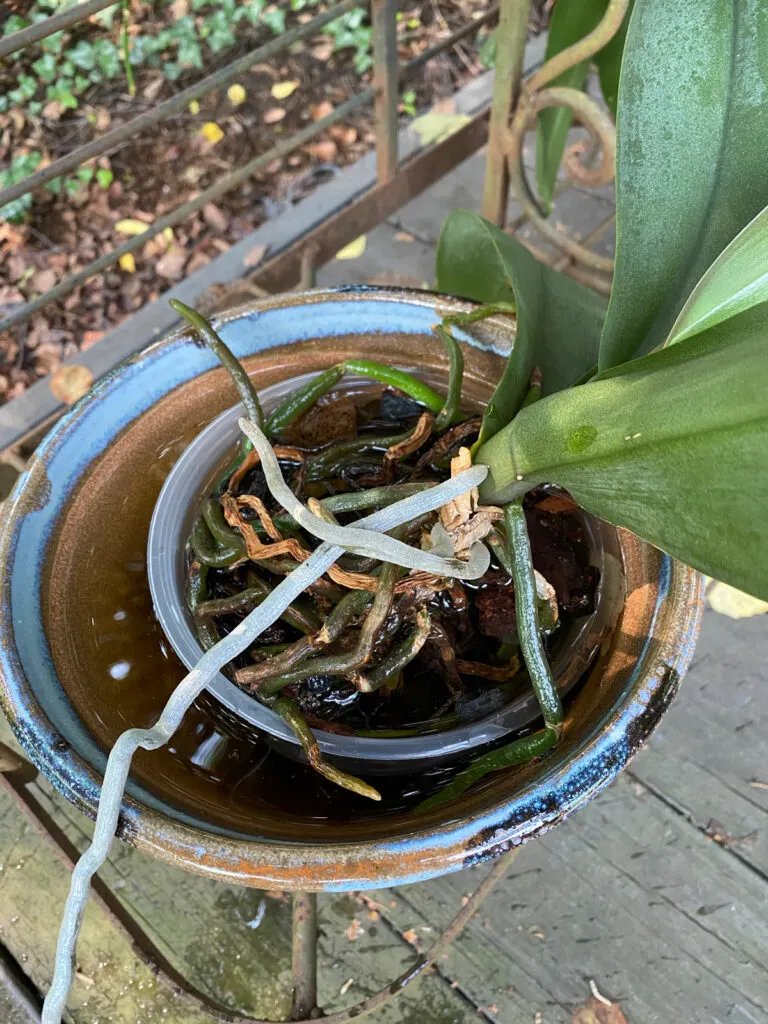
In the photo below, I lifted my clear plastic pot (with drainage holes) and allowed excess water to drain away, and then I dumped the excess water out of the exterior ceramic pot and placed the plant back in.
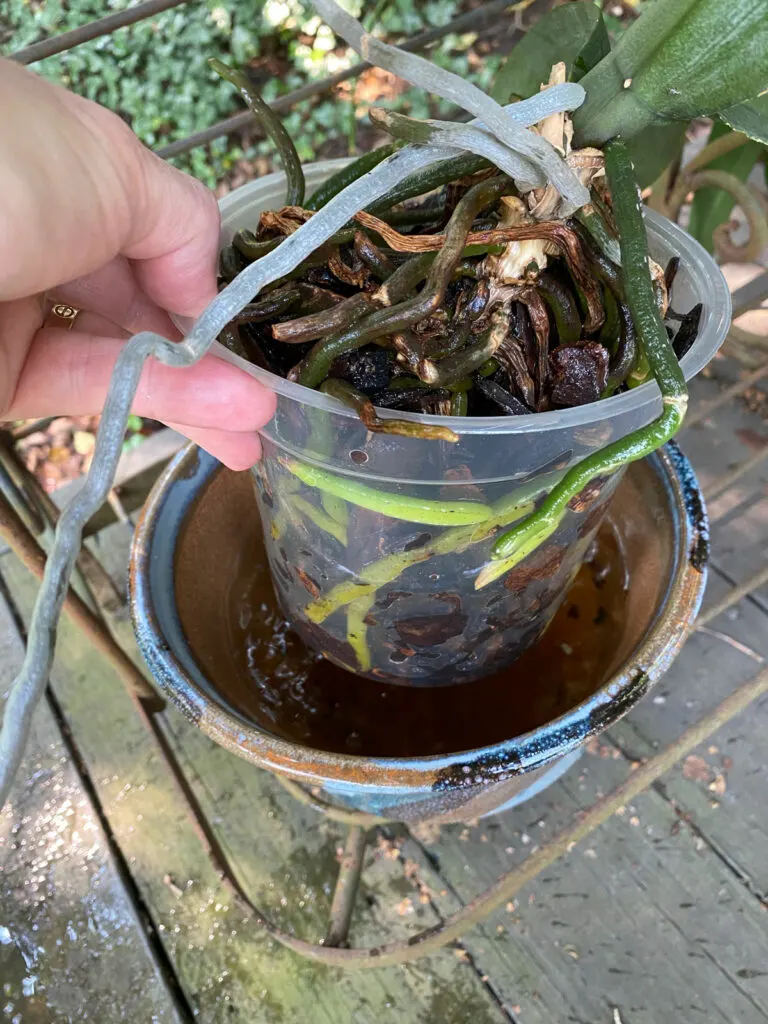
How do you know when to water your orchid?
Moth orchids do not like to go completely dry. If your potting media has gone completely dry, go ahead and water immediately otherwise your plant will start to suffer.
The downside of moth orchids that is that they only grow one or two new leaves per year in many cases, so if you are not attentive with watering, you can get droopy orchid leaves and yellow leaves rather quickly.
Here are some additional watering tips:
- Stick your finger in the bark mix or sphagnum moss. If it feels wet, don’t water. If it is just barely damp, you can probably wait another day or two. This is my personal, preferred method.
- If you don’t want to use the finger test, you can either employ the pencil trick. Stick the sharpened end of a pencil deep into the potting medium. Leave it in for a few minutes, and if it has darkened, there is enough moisture. If it appears the same color, go ahead and water. You can even use a bamboo chopstick or wooden skewer as an alternative.
- If your home has very low humidity, your potting media (as well as the aerial orchid roots) will dry out more quickly so keep an eye on things! In a more humid environment, your potting media will take longer to dry out.
- If your orchid is growing in sphagnum moss, water whenever the top inch or two has dried out.
- If your orchid is growing a bark mix, I think it’s OK to use a watering schedule. I never use a strict watering schedule for plants growing in soil/potting mix, but you would be safe to do a once a week watering schedule for orchids growing in a bark mix.
Why you should not use ice to water your orchids
The natural habitat of most Phalaenopsis orchids is warm and tropical so ice makes no sense.
In fact, if ice that comes in contact with an orchid’s roots they’ll quickly become damaged. There are several reasons why this can be dangerous, and I’ve written a detailed blog post that described why you shouldn’t water orchids with ice.
Lastly…are you having a hard time getting your orchid to rebloom? Check out my post to help you out:
How to Make an Orchid Grow a New Spike – 1 Little Known Secret

How do you water your orchids? Comment below. I’d love to hear!

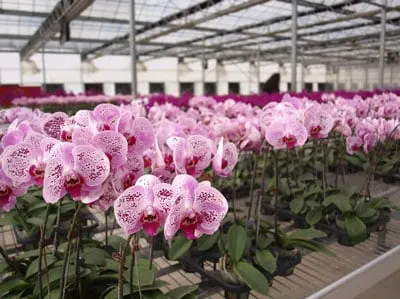
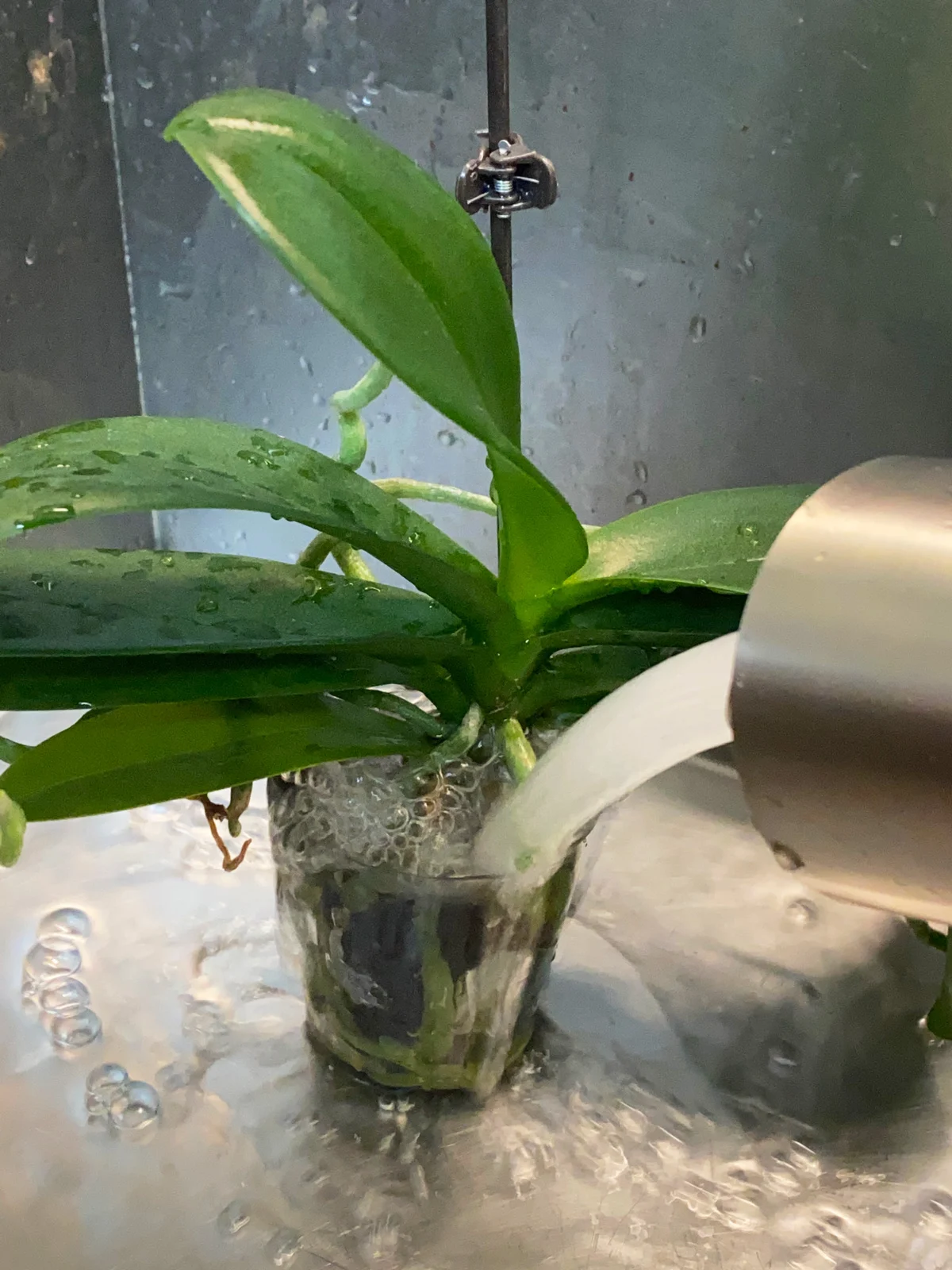
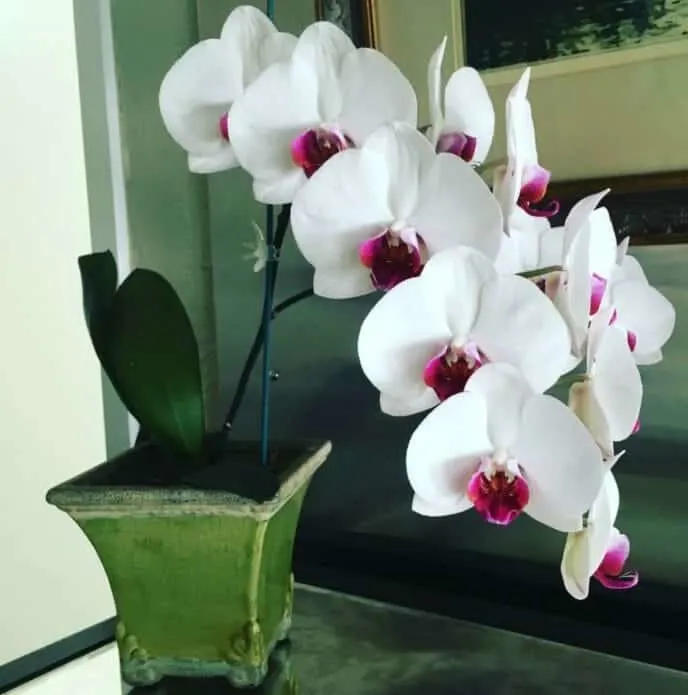
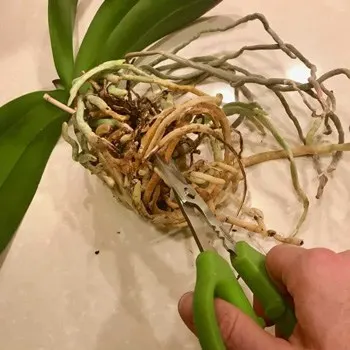
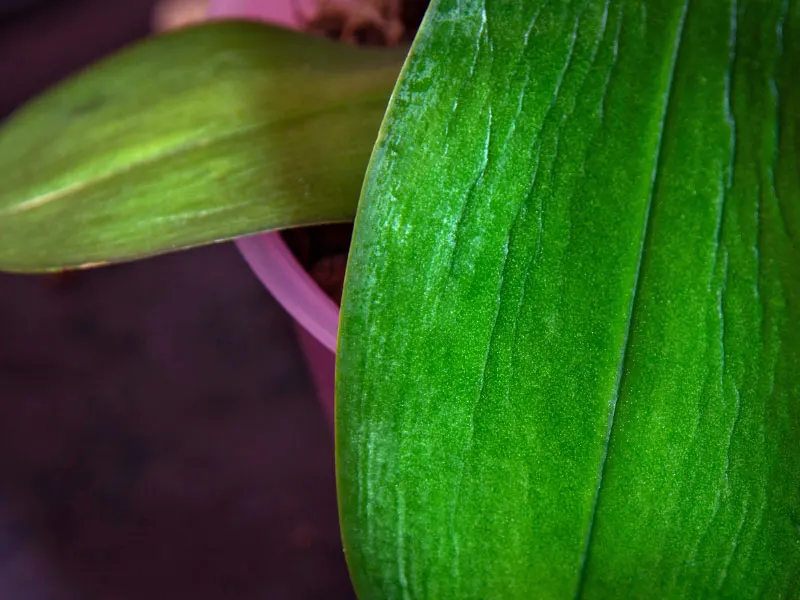
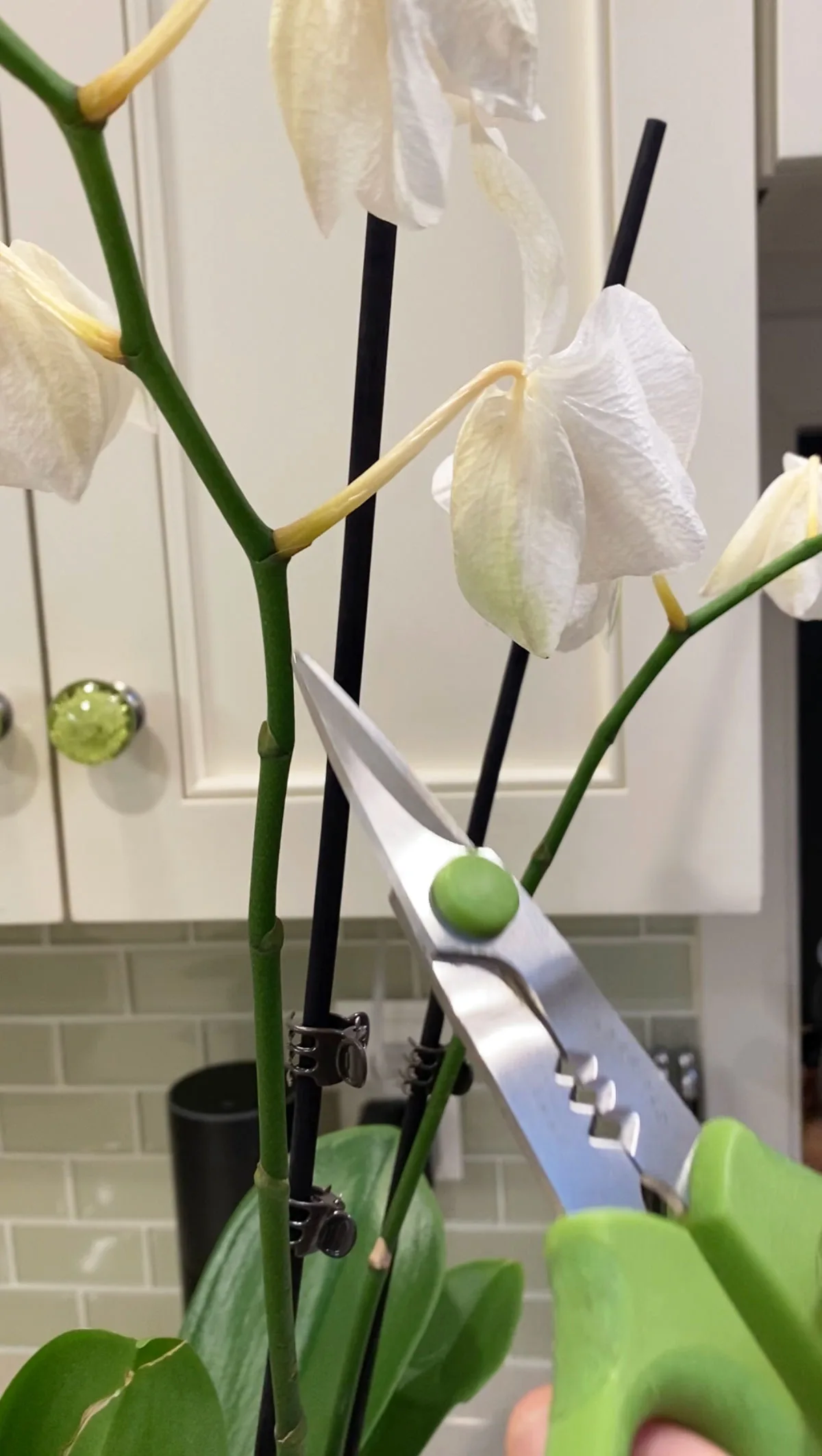
Marilynkellenberger
Thursday 26th of October 2023
I’m unable to purchase your book 4.99 with tax don’t use PayPal just use debit.What is another way to receive your book with debit . Enjoy your blog very much . So easy to understand .very clear. Checked other no info like yours. Needing help have 3 pots I have repotted . Have questions on that and other questions.
Raffaele
Thursday 26th of October 2023
I'm glad you enjoy my content! I assume you tried purchasing directly from my website? You can also purchase Moth Orchid Mastery from Amazon. Let me know if you have any further issues!
Angie W.
Saturday 30th of September 2023
Love the article, nicely done. Couldn't agree more about no ice for orchids. Orchids are a tender tropical, right? Only ones who benifit from ice at the roots are the growers who want to sell you the next one when this one dies. I am by no means an expert, more along lines of novice teetering towards enthusiast. Sadly, I have killed enough plants to recognize some of the troublemakers. All 3 have to do with water. First and foremost would be overwatering and/or not draining away of excess water. Every couple of days,or even weekly, was just too much. Soil needs stay damp, not be constantly wet. Always wet is swamp conditions and most plants simply can't survive that. Adding some marbles or rocks between plastic liner and container lifts liner out of any standing water that may accumulate and increases humidity and air flow for plant. Also makes it easier to lift out liner for waterings. Have found it best to water every 10 days. I water on any date that ends in a zero. A 10-15 mins soak with 1/4 - 1/2 strength orchid food and half of rate for liquid Superthrive. Longer soaks when it's hot and dry, stronger feedings while growing leaves. Currently have 10 Phal orchids. They each has 3-5 new leaves since last bloom and thick roots with very few aerial roots. Another major culprit was the growing material the growers used to grow plant in. By the time plant is mature enough to bloom whatever it was started in is basically spent and is now just an invitation for rot. What once was used to help regulate water now just holds too much, right there at the roots. It just needs to be removed from plant. All of it. Usually do that when repotting after blooms fade. 3rd most common killer was that nurseries tend to plant their plants too deep. Bottommost leave should be above the soil level to keep water from getting trapped and crown rot from setting in. Whenever I get an orchid in bloom usually gently lift plant slightly and work down/remove material until bottom leave is above waterline.
Raffaele
Saturday 30th of September 2023
Hi Angie! Glad you enjoyed the article. And yes, these are all great insights that you've shared! Everyone must really work to figure out what works best for themselves since our growing conditions are all different. Most people just don't take the time to observe things like you do, so kudos to you! :-) Have fun with your Phals! They're such wonderful plants.
Annette
Tuesday 19th of September 2023
Just got an orchid that's flowers are healthy but the bottom part of flower is curled up. Watered it and has been a few days still curled up. Should I soak the plant more? The leaves also are a light green color. Does Epsom salt work on the plant to green it up? My house is dry because of fire stove used for heating it so okay to put a tray with pepples and rocks with water for moisture regularly?
Raffaele
Wednesday 20th of September 2023
Are you on Instagram? Can you maybe DM me some photos? I'd like to see photos so I can help. When the buds start to open, they will stay curled for a while until they flatten out when the flowers are fully open. Perhaps this is what you're talking about? Are you fertilizing at all? Where exactly do you have your plant in terms of light (how far from a window and what exposure is the window?). If you can provide some more details, I can try and help! It is perfectly ok to place it on a tray with pebbles and water to provide additional humidity. Just make sure that the drainage holes at the bottom of the pot are not under water.
Karen
Wednesday 3rd of May 2023
Thank you so much for the watering info. I think my Orchid will start to come alive since I’m using method #1 and stop using ice.
Raffaele
Friday 5th of May 2023
You're very welcome Karen!
Ray
Friday 21st of April 2023
Thank you very much for this!
Raffaele
Friday 21st of April 2023
You're very welcome Ray!